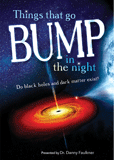Why Is the Universe Dominated by Matter?
If the universe began with a big bang, then the universe ought to have equal amounts of matter and antimatter. But the universe obviously is dominated by matter, so there is an asymmetry between the amount of matter and antimatter. Baryons are a class of particles that include protons and neutrons. Protons and neutrons provide nearly all the mass of matter as we know it. Electrons, the other constituent of normal matter, belong to a class of particles called leptons, but they have only about 0.05% the mass of protons or neutrons. There are reasons to believe that the number of electrons must equal the number of protons. Since baryons dominate the matter of the universe, this problem for the big bang model is called the baryon asymmetry problem.
Antimatter may sound more like science fiction than science, but there are many good reasons to believe in antimatter. In 1928 Paul Dirac was the first to predict the existence of antimatter within the modern understanding of physics. Confirmation soon followed with Carl D. Anderson’s discovery of positrons, or antielectrons, in 1932. Other antiparticles have been detected since. Particles of matter and antimatter are very similar. The most obvious difference for charged particles is that antimatter particles have opposite charge from their matter counterparts. When a particle and its corresponding antiparticle meet, they annihilate one another in a burst of energy. The energy released is the equivalent of the particles’ masses via the famous E = mc2 Einstein equation.
The reverse process also is possible—energy can be converted into a pair of a particle and its corresponding antiparticle. The easiest way for this to happen is when two gamma rays collide. Gamma rays are high-energy photons of electromagnetic radiation. In the early big-bang universe, gamma rays would have been common, so collisions of gamma rays ought to have given rise to many pairs of particles and antiparticles. This is the process whereby the big bang supposedly produced matter, so the universe ought to have equal amounts of matter and antimatter. However, the universe clearly is dominated by matter with virtually no antimatter. How can this be?
To solve this baryon asymmetry problem, theoretical physicists developed theories of how there is a small asymmetry of elementary particles in favor of matter over antimatter. That is, there is a small difference beyond charge in the properties of matter and antimatter. One way that such a difference would show up is that the antiproton would have a shorter half-life than the proton. In this manner, the early big-bang universe would have produced slightly more matter than antimatter. Once the universe expanded and cooled so that matter and antimatter were no longer being produced in large quantities, all of the antimatter disappeared as it annihilated with most of the matter. The matter that remains in the universe today represents the very small asymmetry in favor of matter that initially existed.
A few decades ago, there was much discussion about the baryon asymmetry problem for the big bang model. However, since then there has been little discussion of this problem, because the theoretical asymmetry between matter and antimatter supposedly solved this problem. But now a recent report has called this solution into question.1 This would appear to disprove the theories of fundamental asymmetry between matter and antimatter. There are strong theoretical reasons to believe that there is symmetry between particles and antiparticles, but now there is good experimental evidence too. The only reason why so many physicists believe in baryon asymmetry is that without it, the big bang model is not viable. That is, the baryon asymmetry problem for the big bang still exists.
Of course, the asymmetry between matter and antimatter is not a problem if God created the universe as Genesis 1 says that He did. This is because God created everything with purpose, and it obviously suited His purpose to create a matter-dominate universe. The big bang model suffers from other problems, such as the flatness and horizon problems. Those problems supposedly were solved by invoking cosmic inflation, but, like the supposed solution to the baryon asymmetry problem, there are no data to support cosmic inflation either. The big bang theory is a house of cards with numerous ad hoc assumptions. How foolish it is for Christians to embrace the transitory big bang model when it contradicts the clear and certain word of God.
Footnotes
- S. Ulmer et al., “High-precision Comparison of the Antiproton-to-Proton Charge-to-Mass Ratio,” Nature 524 (August 13, 2015): 196–199, doi:10.1038/nature14861.
Recommended Resources

Answers in Genesis is an apologetics ministry, dedicated to helping Christians defend their faith and proclaim the good news of Jesus Christ.
- Customer Service 800.778.3390
- © 2024 Answers in Genesis








